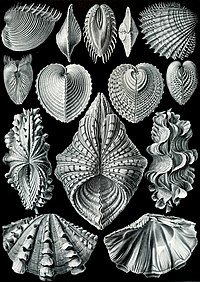
Photo from wikipedia
Shell growth rates in relationship to seasonal changes of environmental factors were studied in a wild population of the Yesso scallop Mizuhopecten yessoensis inhabiting Amur Bay (Peter the Great Bay,… Click to show full abstract
Shell growth rates in relationship to seasonal changes of environmental factors were studied in a wild population of the Yesso scallop Mizuhopecten yessoensis inhabiting Amur Bay (Peter the Great Bay, Sea of Japan, Russia). It was found that food availability is not a limiting factor for the scallop growth in the study area. A phytoplankton biomass of 3.5–6.0 g m–3 provided high scallop growth rates. The largest daily shell increments were observed with a phytoplankton biomass of about 6 g m–3. With a decrease in the phytoplankton biomass to <2 g m–3, as well as with an increase to >11 g m–3, the daily shell increments reduced. It appeared that the main exogenous factors causing the seasonal variations in the scallop growth rates are the water temperature, which was too high in July and August (>18 °C) and too low in November–April (<4 °C), and the water salinity, which was too low (<30‰) for this stenohaline species in summer. The relationship of the daily shell increment in Yesso scallop with the water temperature can be described by a dome-shaped curve. The largest increments were observed at 8–16 °C. The dependence of the daily shell increments on the water salinity was also best described by a dome-shaped curve, showing the optimal range of 32.5–33.5‰. The revealed relationships, approximated by dome-shaped curves, evidently indicate that both insufficient and excessive effect of the factor negatively affects scallop growth. A suggestion was made to describe the result of the combined impact of several environmental factors on the daily shell increment as a multiplication of the functions of its dependence on each of the factors.
Journal Title: PeerJ
Year Published: 2023
Link to full text (if available)
Share on Social Media: Sign Up to like & get
recommendations!